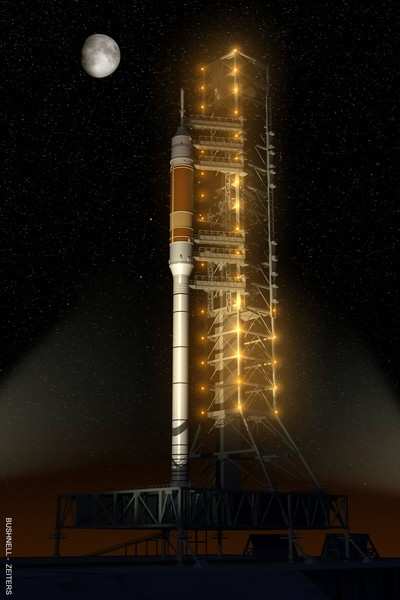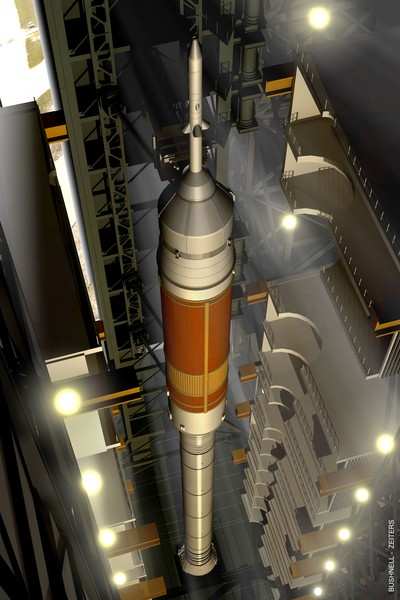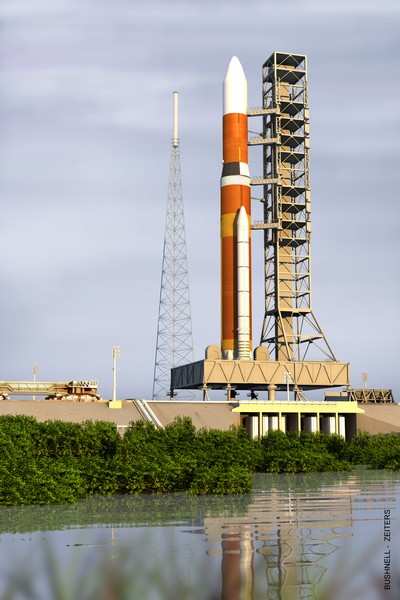 NASA has updated ANN
with the news that Ares rockets that will take over for the
space shuttle and carry humans to the moon are closer to lifting
off from the drawing board. Designs and modifications are under way
at Launch Pad 39B, the Launch Control Center and the Vehicle
Assembly Building at NASA's Kennedy Space Center in Florida to
accommodate the first test flight of an Ares I rocket in April
2009.
NASA has updated ANN
with the news that Ares rockets that will take over for the
space shuttle and carry humans to the moon are closer to lifting
off from the drawing board. Designs and modifications are under way
at Launch Pad 39B, the Launch Control Center and the Vehicle
Assembly Building at NASA's Kennedy Space Center in Florida to
accommodate the first test flight of an Ares I rocket in April
2009.
At the same time, workers in Kennedy’s Assembly and
Refurbishment Facility and Parachute Refurbishment Facility are
working on the components for the first launch test. It is all part
of a plan to use rockets based largely on technology proven in the
Space Shuttle Program as the foundation for America's next
generation of crewed spacecraft. One rocket, the Ares I, will pick
up where the shuttle leaves off as America’s prime vehicle
for launching humans. The other, Ares V, will launch everything
else needed for trips to the moon.
The demonstration rocket for the 2009 test, Ares I-X, will look
just like the rocket that will launch astronauts to the
International Space Station in the next decade and on the first leg
of trips to the moon beginning in 2020.
The test flight calls for a surplus shuttle solid rocket booster
to be topped with an inactive fifth segment, a non-working upper
stage and a boilerplate capsule built to the dimensions of the
Orion spacecraft that will carry humans to Earth orbit.
But for the 2009 test flight, the capsule will carry only
instruments and will launch on a ballistic trajectory into the
South Atlantic Ocean. This will allow engineers to study the
conditions Ares I will experience at liftoff, while the solid
rocket is thundering toward space and when the second-stage rocket
and spacecraft separate.
A second unmanned test flight with higher fidelity upper stage
and Orion spacecraft simulators is planned for 2012. The first
crewed flight of Ares I and Orion is scheduled for no later than
2015.
Although the rocket is a new design, NASA is following a plan
that allows the agency to use many facilities that already
exist.

"The infrastructure we have for shuttle is mainly what we're
going to use," said Pepper Phillips, manager of Kennedy's Ground
Operations Project in the Constellation Program.
Constellation encompasses the Ares rockets and the Orion
capsules under development, as well as the lunar landers and
surface systems that will be used by astronauts exploring the
moon.
Here is a detailed look at the changes already under way around
Kennedy to get ready for that test flight. It also is a look ahead
at what needs to be done so the Constellation Program can begin
Ares I crewed missions, as well as Ares V missions beyond 2015.
Launch Pad 39B
Role in Constellation: Launch complex for the Ares I-X and
operational flights of the Ares I rocket.
Status: Launch Pad 39B has hosted its last
planned space shuttle launch, though it will be kept ready in case
an emergency flight is called for during the last Hubble Space
Telescope repair mission in September 2008. Then major work will
begin.
To be done: The fixed and rotating service
structures standing at Launch Pad 39B will be dismantled sometime
after the Ares I-X test flight. A new launch tower for Ares I will
be built onto a new mobile launch platform.
The gantry for the shuttle doesn't reach much higher than the
top of the four segments of the solid rocket booster. Pad access
above the current shuttle launch pad structure will not be required
for Ares I-X because the stages above the solid rocket booster are
inert.
For the test scheduled in 2012 or for the crewed flights,
workers and astronauts will need access to the highest levels of
the rocket and capsule. When the Ares I rocket rolls out to the
launch pad on the back of the same crawler-transporters used now,
its launch gantry will be with it. The mobile launchers will nestle
under three lightning protection towers to be erected around the
pad area.
Kennedy's Constellation managers say the Ares' time at the
launch pad will be significantly less than the three weeks or more
the shuttle requires. This “clean pad” approach
minimizes equipment and servicing at the launch pad. It is the same
plan NASA used with the Saturn V rockets and industry employs it
with more modern launchers.
The launch pad will also get a new emergency escape system for
astronauts, one that looks very much like a roller coaster. Cars
riding on a rail will replace the familiar baskets hanging from
steel cables.
Launch Pad 39A
Role in Constellation: Launch Pad 39A will be
the home of the Ares V rocket, a behemoth vehicle almost as tall as
the Saturn V, and even more powerful. The Ares V will not carry a
crew, but is slated to loft a lunar lander and a fueled upper stage
that will connect with an Orion capsule in Earth orbit. The upper
stage from the Ares V will ignite to send the Orion and lander
toward the moon.

Status: The launch complex that saw the liftoff
of Apollo 11 to the moon will be used for the space shuttle until
the orbiters are retired around 2010.
Vehicle Assembly Building
Role in Constellation: The giant hangar used to
stack the Saturn V rocket and space shuttles will retain that role
in the Constellation Program. It is the only structure at Kennedy
tall enough to accommodate the Ares rockets.
Status: The building's high bay 3 is undergoing
minor changes to handle the Ares I-X rocket. The new vehicle is
about 150 feet taller than the shuttle orbiter, so bigger changes
will be needed for the final Ares I design. Work platforms similar
to those used in Apollo will give workers the access they need to
stack the pieces and process the rocket for launch.
To be done: After the shuttle fleet retires,
high bay 1 will be converted to handle the mammoth Ares V rockets.
Cranes that assembled the last rockets destined for the moon will
again be used to attach pieces for a moon ship.
Launch Control Center Firing Room 1
Role in Constellation: Firing Room 1 already
holds the distinction of overseeing the first launch of a space
shuttle and supporting the Apollo Program. Now it is poised to take
on the task of controlling the first launch of the shuttles'
replacement.
Status: The expansive room inside the Launch
Control Center is gutted and the windows on the doors are papered
over. It won't stay that way for long, though, because NASA wants
members of its launch team to begin practicing with the new
equipment and procedures in summer 2008.
About that launch team: While it takes more
than 200 people in the Launch Control Center at Kennedy to launch a
space shuttle mission, Phillips said the Ares launch team is
targeted to number fewer than 50.

"This vehicle is far less complex than a shuttle system,"
Phillips said. "We recognize it's a less complex vehicle, so we're
looking to use a simpler launch control system."
Assembly and Refurbishment Facility
Role in Constellation: The Assembly and Refurbishment Facility
processes the nosecones and aft skirts of the shuttle solid rocket
boosters before they are bolted onto the fueled segments. The Ares
1 doesn't require a booster nosecone, but the aft skirt for the
test flight is already being prepped.
Status: Engineers are modifying the aft skirt
so it can behave a bit differently as the main booster for the Ares
I. C.J. Smith of United Space Alliance noted the small rockets that
push a booster away from a shuttle during launch will be used to
help separate the upper stage from the solid rocket after the first
part of the flight.

Parachute Refurbishment Facility
Role in Constellation: Parachutes will allow
controlled returns to Earth for both the Orion capsule and the Ares
I solid rocket booster. The refurbishment center is getting the
first parachutes of the program ready and will overhaul them for
reuse.
Status: Parachutes are already being stitched
for upcoming drop tests in Yuma, Ariz.
Mobile Launch Platforms
Role in Constellation: NASA will stick with
mobile launch platforms throughout the Constellation Program, the
same concept it has used since the Saturn V. Earlier rockets were
small enough to be assembled at the pad. For the 2009 test flight,
workers will modify one of the three existing launch platforms to
handle the Ares I stack. The 2012 test flight and subsequent
launches will use a new mobile platform design.
Status: NASA has awarded a contract to
Reynolds, Smith and Hills Inc., located at Merritt Island, Fla.,
for the design of a new mobile launcher structure dedicated to the
Ares I. The platform will hold the rocket and the service
structure.
Crawler-Transporters
The work of the crawler-transporters is far from finished. After
hauling Saturn Vs to the launch pad during Apollo and Skylab and
carrying space shuttles back and forth from the Vehicle Assembly
Building to the launch pads for almost 30 years, the crawlers are
nowhere near retirement. The vehicles are planned to carry the new
rockets, launch platforms and service gantries to the launch
complexes.
Status: There are no major overhauls planned
for the beefy vehicles, but they will need a little more muscle in
the form of reinforcement to carry the Ares rockets. NASA is
working to use the crawlers “as-is” for Ares I, but the
Ares V will require more carrying capacity. Phillips said studies
are ongoing to determine exactly how much work the crawlers will
need.
 ANN's Daily Aero-Linx (04.15.24)
ANN's Daily Aero-Linx (04.15.24) Classic Aero-TV: 'No Other Options' -- The Israeli Air Force's Danny Shapira
Classic Aero-TV: 'No Other Options' -- The Israeli Air Force's Danny Shapira Aero-News: Quote of the Day (04.15.24)
Aero-News: Quote of the Day (04.15.24) Airborne 04.16.24: RV Update, Affordable Flying Expo, Diamond Lil
Airborne 04.16.24: RV Update, Affordable Flying Expo, Diamond Lil ANN's Daily Aero-Term (04.16.24): Chart Supplement US
ANN's Daily Aero-Term (04.16.24): Chart Supplement US







